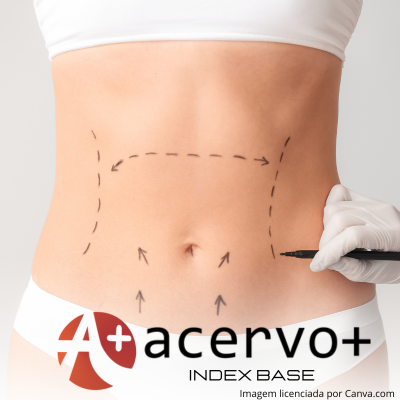Benefícios e desvantagens da abdominoplastia com preservação da Fáscia de Scarpa
##plugins.themes.bootstrap3.article.main##
Resumo
Objetivo: Avaliar os benefícios e desvantagens da técnica de preservação da fáscia de Scarpa nas cirurgias de abdominoplastia. Métodos: Trata-se de uma revisão integrativa realizada pela utilização as bases de dados National Library of Medicine (PubMed) e Portal Regional da Biblioteca Virtual em Saúde (PR-BVS) com os descritores “Abdominoplasty” AND “Scarpa fascia”. Os critérios de inclusão consistiram em artigos de estudos observacionais e ensaios clínicos controlados, disponíveis em inglês, português ou espanhol. Os critérios de exclusão aplicados foram estudos duplicados e que fugiam ao tema principal. O universo consistiu em 11 trabalhos científicos. Resultados: Foi atribuído como relevante o menor débito drenado, tempo permanência com o dispositivo de sucção, tempo de hospitalização e incidência de seroma. Em contrapartida, a dificuldade de acesso do plano operatório e a ausência de melhora significante da perfusão abdominal ao estudo com imagem por fluorescência infravermelha se apresentaram como possíveis limitadores da técnica. Considerações finais: Foi possível verificar que a dissecção em plano superficial é majoritariamente vantajosa mediante ao correto alinhamento de expectativas. A tomada de decisão deve levar em consideração tanto aspectos importantes ao paciente quanto questões cirúrgicas observadas pelo profissional médico.
##plugins.themes.bootstrap3.article.details##
Copyright © | Todos os direitos reservados.
A revista detém os direitos autorais exclusivos de publicação deste artigo nos termos da lei 9610/98.
Reprodução parcial
É livre o uso de partes do texto, figuras e questionário do artigo, sendo obrigatória a citação dos autores e revista.
Reprodução total
É expressamente proibida, devendo ser autorizada pela revista.
Referências
2. AHERRERA AS, et al. Evaluation of Abdominal Cutaneous Sensibility Following Abdominoplasty. Plastic and Reconstructive Surgery, 2015; 135(3): 526-32.
3. ANDRADES P e PRADO A. Composition of Postabdominoplasty Seroma. Aesthetic Plastic Surgery, 2007; 31(5): 514-8.
4. BOSSERT RP e RUBIN JP. Evaluation of the Weight Loss Patient Presenting for Plastic Surgery Consultation. Plastic and Reconstructive Surgery, 2012; 130(6): 1361-9.
5. BRAGG TW, et al. Patient Satisfaction Following Abdominoplasty: an NHS Experience. Journal of Plastic, Reconstructive & Aesthetic Surgery, 2007; 60(1): 75-8.
6. CORREIA-GONÇALVES I, et al. Abdominoplasty with Scarpa Fascia Preservation - Comparative Study in a Bariatric Population. Surgery for Obesity and Related Diseases, 2017; 13(3): 423-8.
7. COSTA-FERREIRA A, et al. Scarpa Fascia Preservation during Abdominoplasty: a Prospective Study. Plastic Reconstructive Surgery, 2010; 125(4): 1232-1239.
8. COSTA-FERREIRA A, et al. Scarpa Fascia Preservation during Abdominoplasty: Randomized Clinical Study of Efficacy and Safety. Plastic Reconstructive Surgery, 2013; 131(3): 644-51.
9. DI MARTINO M, et al. Seroma in Lipoabdominoplasty and Abdominoplasty: a Comparative Study using Ultrasound. Plastic Reconstructive Surgery, 2010; 126(5): 1742-51.
10. EDMONDSON SJ e ROSS DA. The Postpartum Abdomen: Psychology, Surgery and Quality of life. Hernia, 2021; 25(4): 939-50.
11. INFORZATO HCB, et al. Anchor-Line Abdominoplasty with Scarpa Fascia Preservation in Postbariatric Patients: A Comparative Randomized Study. Aesthetic Plastic Surgery, 2020; 44(2): 445-52.
12. ISAPS. INTERNATIONAL SOCIETY OF AESTHETIC PLASTIC SURGERY. 2023. Aesthetic Procedures Close to 35 Million in 2023. Disponível em: https ://www.isaps.org/. Acesso em: 16 de agosto de 2024.
13. KITZINGER HB, et al. After Massive Weight Loss: Patients' Expectations of Body Contouring Surgery. Obesity Surgery, 2012; 22(4): 544-8.
14. KOLLER M e HINTRINGER T. Scarpa fascia or rectus fascia in abdominoplasty flap elevation: a prospective clinical trial, Aesthetic Plastic Surgery, 2012; 36(2): 241-3.
15. LE LOUARN C. Partial Subfascial Abdominoplasty. Aesthetic Plastic Surgery, 1996; 20(2): 123-7.
16. LOCKWOOD T. Fegli-lateral-tension Abdominoplasty with Superficial Fascial System Suspension. Plastic and Reconstructive Surgery, 1995; 9: 603-8.
17. MATARASSO A e SMITH DM. Strategies for Aesthetic Reshaping of the Postpartum Patient. Plastic Reconstructive Surgery, 2015; 136(2): 245-57.
18. MONTEIRO IA, et al. Postbariatric Abdominoplasty: A Comparative Study on Scarpa Fascia Preservation Versus Classical Technique. Aesthetic Plastic Surgery, 2023; 47(6): 2511-24.
19. NAHAI FR. Anatomic Considerations in Abdominoplasty. Clinics in Plastic Surgery, 2010; 37(3): 407-14.
20. NOVAIS CS, et al. Abdominoplasty with Scarpa Fascia Preservation: Randomized Controlled Trial with Assessment of Scar Quality and Cutaneous Sensibility. Plastic Reconstructive Surgery, 2020; 146(2): 156-64.
21. PITANGUY I. Abdominal Lipectomy. Clinics in Plastic Surgery, 1975; 2(3): 401-10.
22. PITANGUY I. Abdominal Lipectomy: An Approach to it Through an Analysis of 300 Consecutive cases. Plastic and Reconstructive Surgery, 1967; 40: 384-92.
23. SALDANHA FILHO OR, et. al. Avaliação quantitativa do débito do dreno na lipoabdominoplastia - estudo comparativo. Revista Brasileira de Cirurgia Plástica, 2014; 29(2): 259-63.
24. SCHAVERIEN M, et al. Arterial and Venous Anatomies of the Deep Inferior Epigastric Perforator and Superficial inferior Epigastric Artery Flaps. Plastic Reconstructive Surgery, 2008; 121(6): 1909-19.
25. SHEHAB ME, et al. Satisfaction and Quality of Life in Patients Who Underwent Post Massive Weight Loss Body Contouring Procedures: A Tertiary Center Experience in Bahrain. World Journal of Plastic Surgery, 2024; 13(1): 71-82.
26. SWANSON E. Comparison of Limited and Full Dissection Abdominoplasty Using Laser Fluorescence Imaging to Evaluate Perfusion of the Abdominal Skin. Plastic and Reconstructive Surgery, 2015; 136(1): 31-43.
27. TAYLOR GI e DANIEL RK. The Anatomy of Several Free Flap Donor Sites. Plastic and Reconstructive Surgery, 1975; 56(3): 243-53.
28. TAYLOR J e SHERMAK M. Body Contouring Following Massive Weight Loss. Obesity Surgery, 2004; 14(8): 1080-5.
29. VALENÇA-FILIPE R, et al. Classic Versus Scarpa-sparing abdominoplasty: An infrared thermographic comparative analysis. Journal of Plastic, Reconstructive & Aesthetic Surgery, 2023; 82: 264-74.
30. WHO. World health organization. 2024. Obesity and overweight. 2024. Disponível em: https ://www.who.int/. Acesso em: 16 de agosto de 2024.
31. WORLD OBESITY FEDERATION. World Obesity Atlas 2024. London, 2024; 1.
32. WULKAN M e HURWITZ D. Preservação e suspensão da fáscia de Scarpa na abdominoplastia. Revista Brasileira de Cirurgia Plástica, 2010; 25(3): 490-8.

